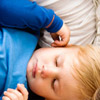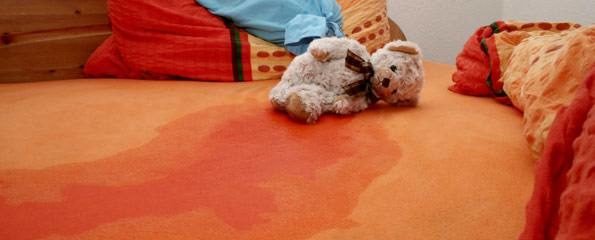Bed wetting in teenagers
In children, bed wetting is a relatively common problem, with as many as 20% of 5 year olds and up to 10% of 10 year olds experiencing it regularly. Despite the fact that bed wetting is something that most affected children tend to outgrow, this is certainly not the case for every individual. Research has shown that as many as 2% of teenagers experience bed wetting, or nocturnal enuresis as it’s medically termed.
The causes
There are two ‘types’ of night-time bed wetting – primary nocturnal enuresis is when an individual has never been dry at night for a period of more than 6 months, and secondary nocturnal enuresis is when bed wetting occurs after a period of at least 6 months of night dryness.
Each of these types has different causes and needs to be dealt with in different ways. Your healthcare professional will know all about this.
In the case of primary nocturnal enuresis (bed wetting), your healthcare professional will enquire if wetting occurs at night without any daytime symptoms (known as monosymptomatic nocturnal enuresis) or if wetting occurs at night accompanied by daytime symptoms, such as frequency and urgency of urination which may occur with or without incontinence (known as non-monosymptomatic nocturnal enuresis). If non-monosymptomatic nocturnal enuresis is present, the daytime symptoms need to be treated first. Usually the individual will be referred to a specialist for further evaluation.
There are three main causes of primary nocturnal enuresis: difficulty rousing from sleep, an overactive bladder and/or overproduction of urine (nocturnal polyuria) at night.
Some individuals find it more difficult to wake up than others and the reasons they do not wake up in response to a full or contracting bladder are not yet fully understood. However, reduced arousal threshold is a recognised cause of bed wetting.
A reduced bladder capacity results from an overactive or “twitchy” bladder. It is when the bladder experiences involuntary contractions at night resulting in wetting despite functioning normally during the day. Reduced bladder capacity is thought to cause bed wetting in about one-third of individuals.
Nocturnal polyuria occurs when the overnight urine production exceeds ‘normal’ levels, because in individuals who wet the bed, levels of a naturally occurring substance produced in the brain at night called vasopressin, may be insufficient. It’s a situation that makes it practically impossible for the bladder to “hold on” to urine until the next morning.
Risk factors
 Other risk factors for primary nocturnal enuresis include constipation, developmental delay and other neurological dysfunction, attention deficit hyperactivity disorder, upper-airway obstruction and sleep apnoea.
Other risk factors for primary nocturnal enuresis include constipation, developmental delay and other neurological dysfunction, attention deficit hyperactivity disorder, upper-airway obstruction and sleep apnoea.
As for secondary nocturnal enuresis, while some of the same risk factors for the primary type of bed wetting apply such as constipation and upper-airway obstruction, other risk factors include urinary tract infections, the onset of diabetes, stress, sexual abuse and other psychopathological conditions.
The effects
When a bed wetting problem does persist past a child’s 10th birthday, it’s more likely to be classified as severe, which means they wet the bed more than 3 nights per week. In fact, at least one study over a 2 week observation period showed how in adolescents who wet the bed, 80% of them were wet 3 or more nights per week, while 45% were wet every night.
Not surprisingly, it’s a problem that can have a big effect on a teenager’s life. It’s common for adolescents with nocturnal enuresis to feel guilty and ashamed, they may avoid social activities and report feeling ‘different’ from their peers. But despite the impact the problem can have, a significant number of teenagers with a bed wetting problem have probably never seen a doctor about it.
The treatments
First-line therapy for bed wetting is usually an enuresis alarm. Alarm therapy works by waking the person at the exact moment when wetting begins. This therapy improves arousal from sleep, and helps to alert and sensitise the person to respond to a full bladder during sleep.
It’s generally recommended that alarm therapy be continued for at least 2 to 3 months, or until they achieve 14 consecutive dry nights.
There are also medications available to treat bed wetting. One of them has an active ingredient called desmopressin. It works like vasopressin which is a naturally occurring substance produced in the brain. For children or teenagers who wet the bed as a result of low levels of vasopressin during the night, desmopressin supplements the body’s natural vasopressin, thus reducing the amount of urine produced during the night.
Oxybutynin is an anticholinergic medication and may be used if a person has an overactive bladder during sleep. Tricyclic antidepressants such as imipramine, are also approved for the treatment of bed wetting. However, they are less commonly recommended because of their potential side-effects.
You may also hear about other treatments that are less commonly used such as hypnosis, acupuncture, psychotherapy, reward systems and fluid restriction. It has not been established whether these treatments are effective in managing bed wetting .
 | For more information about bed wetting including lifestyle advice, how the urinary system works and much more, see Bed Wetting (Nocturnal Enuresis). |
References
- Robson WL. Clinical practice: Evaluation and management of enuresis. N Engl J Med 2009; 360(14): 1429-36. [Abstract]
- Caldwell PHY et al. Bed wetting and toileting problems in children. Med J Aust 2005; 182(4): 190-5. [Abstract | Full text]
- Moulden A. Management of bed wetting . Aust Fam Physician. 2002; 31(2): 161-3. [Abstract]
- Rocha MM, CostaNJ, Silvares EFM. Changes in parents’ and self-reports of behavioral problems in Brazilian adolescents after behavioral treatment with urine alarm for nocturnal enuresis. Int Braz J Urol. 2008; 34(6): 749-57. [Abstract]
- ButlerRJ, Heron J. The prevalence of infrequent bed wetting and nocturnal enuresis in childhood. Scand J Urol Nephrol. 2008; 42(3): 257-64. [Abstract]
- Lottmann HB, Alova I. Primary monosymptomatic nocturnal enuresis in children and adolescents. Int J Clin Pract Suppl. 2007; (155): 8-16. [Abstract]
- Thiedke CC. Nocturnal Enuresis. Am Fam Physician. 2003; 67(7): 1499-506.
- Nappo S et al. Nocturnal enuresis in the adolescent: a neglected problem. BJU International. 2002; 90: 912-917. [Full text]
- Norgaard JP. Nocturnal enuresis pathogenesis: Pathogenesis and therapeutic implications. Sydney,Australia, 1992, Oxford Clinical Communications.
Dates
Tags
Created by:

 Login
Login














